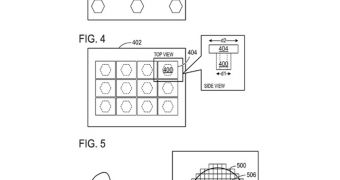One of the biggest problems posed by virtual keyboards available via touchscreen displays is that they don't really offer the same level of physical feedback as their USB or PS/2 counterparts, but it seems that Microsoft might be working on a technology that will actually solve this issue and grant touchscreens a whole new “feeling”. So, as New Scientist informs us, the Redmond software giant has recently filed for a patent regarding the development of touchscreens that would be able to actually change their shape in order to re-create keyboards or other physical objects. This would be possible by using pixel-sized shape-memory plastic cells that can be ordered to protrude from the surface on command. In order to achieve this ambitious goal, Microsoft wants to use a layer of shape-memory plastic placed above a large touchscreen to distort the surface of the screen when different wavelengths of ultraviolet light strike the pixels from beneath. Apparently, the person that came up with this technology, Redmond-based researcher Erez Kikin-Gil, believes that the devices suitable for this technology are mostly large-size displays, such as Microsoft's own Surface table, rather than tablets (although ulterior adaptation to the smaller size screens would probably also be possible). The technology works in a fairly ingenious manner, since a projector built into the Surface displays a computer image onto the table top from below and, as the user touches it, infrared reflections from their fingertips are detected by cameras beneath the table and used to pinpoint the position of the finger and lend touchscreen capability. The light-induced shape-memory plastic polymer we've mentioned earlier becomes hard and protruding when one wavelength of ultraviolet light is transmitted at a pixel, and soft when another wavelength hits it and, by modulating these wavelengths, texture can be created, the patent claims. As far as we're concerned, this technology would prove to be extremely useful if properly developed and implemented, since it would not only allow normal users to enjoy a higher degree of realism when typing on a virtual keyboard or touching certain elements of the display, but it would also enable the use of the devices equipped with such control solutions by people who weren't previously able to do so (such as the visually-impaired).
hot right now

 14 DAY TRIAL //
14 DAY TRIAL //